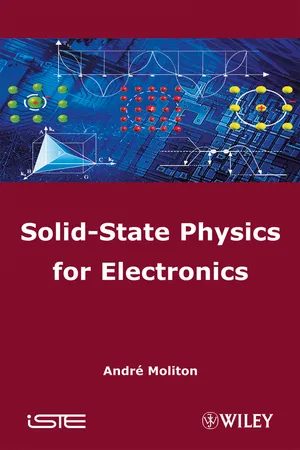
- English
- ePUB (mobile friendly)
- Available on iOS & Android
Solid-State Physics for Electronics
About This Book
Describing the fundamental physical properties of materials used in electronics, the thorough coverage of this book will facilitate an understanding of the technological processes used in the fabrication of electronic and photonic devices. The book opens with an introduction to the basic applied physics of simple electronic states and energy levels. Silicon and copper, the building blocks for many electronic devices, are used as examples. Next, more advanced theories are developed to better account for the electronic and optical behavior of ordered materials, such as diamond, and disordered materials, such as amorphous silicon. Finally, the principal quasi-particles (phonons, polarons, excitons, plasmons, and polaritons) that are fundamental to explaining phenomena such as component aging (phonons) and optical performance in terms of yield (excitons) or communication speed (polarons) are discussed.
Frequently asked questions
Information
Chapter 1
Introduction: Representations of Electron-Lattice Bonds
1.1. Introduction
1.2. Quantum mechanics: some basics
1.2.1. The wave equation in solids: from Maxwell’s to Schrödinger’s equation via the de Broglie hypothesis













1.2.2. Form of progressive and stationary wave functions for an electron with known energy (E)



Table of contents
- Cover
- Titlepage
- Copyright
- Foreword
- Introduction
- Chapter 1: Introduction: Representations of Electron-Lattice Bonds
- Chapter 2: The Free Electron and State Density Functions
- Chapter 3: The Origin of Band Structures within the Weak Band Approximation
- Chapter 4: Properties of Semi-Free Electrons, Insulators, Semiconductors, Metals and Superlattices
- Chapter 5: Crystalline Structure, Reciprocal Lattices and Brillouin Zones
- Chapter 6: Electronic Properties of Copper and Silicon
- Chapter 7: Strong Bonds in One Dimension
- Chapter 8: Strong Bonds in Three Dimensions: Band Structure of Diamond and Silicon
- Chapter 9: Limits to Classical Band Theory: Amorphous Media
- Chapter 10: The Principal Quasi-Particles in Material Physics
- Bibliography
- Index